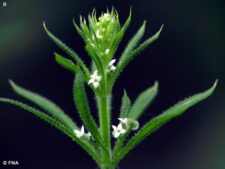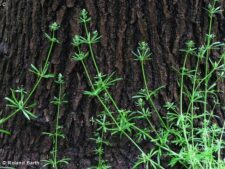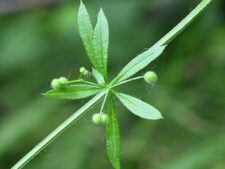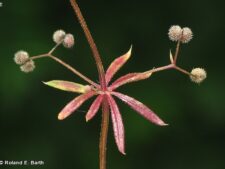
CATCHWEED BEDSTRAW
Galium aparine
MADDER FAMILY (Rubiaceae)
 Identification
Identification
- Flowering time - May, June
- Abundant in floodplain and upland woods
- 4 petals and whorls of 8 leaves
- Feels bristly and clings to clothing (and itself)
- See comments for comparison with other similar bedstraw species
This native annual has reclining, sprawling stems 6 feet and longer. The slender leaves, up to 3 inches long, are usually in whorls of 8 (A,C). The tiny white flowers are found on short stalks from the leaf axils by early May (B). The fruit is a pair of round, hairy orbs (D). By mid-June many of these plants turn a reddish-purple (E). The entire plant is bristly and usually forms dense tangles later in the season. The bedstraws are not that easy to identify but this species is our by far our most common one. See comments section for details on ID.
Abundant on both floodplain and upland woods at Fontenelle Forest and Neale Woods. Flowering occurs in May and June.
Of the three most common bedstraw species one is most likely to encounter at Fontenelle Forest and Neale Woods, this is by far the most common and the only one that usually has leaves occurring in whorls of 8. The less common Sweet-scented Bedstraw (Galium triflorum), usually has whorls of 6 broader leaves while Cross Cleavers (Galium circaezens) has whorls of 4 leaves. Both also tend to flower later in the season (mid-June, July). Two other rare species, Bluntleaf Bedstraw (Galium obtusum) and Shining Bedstraw (Galium concinnum) are not likely to be seen. Neither has as many as 8 leaves in a whorl.
Its propensity to attach itself to clothing or anything that passes by has prompted the rather colorful alternate common name of Sticky-Willy. Cleavers is another alternate name.
The content of NatureSearch is provided by dedicated volunteer Naturalists of Fontenelle Forest who strive to provide the most accurate information available. Contributors of the images retain their copyrights. The point of contact for this page is: Roland Barth.




